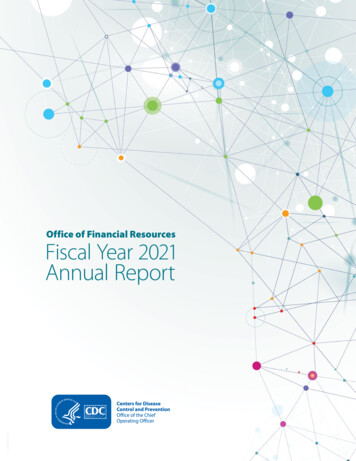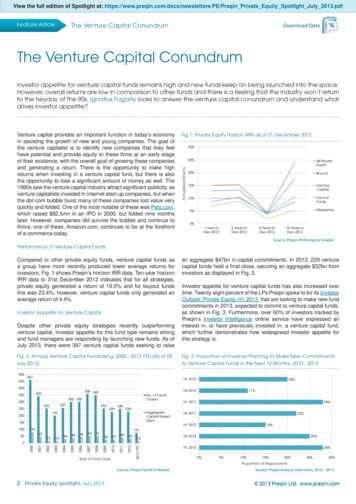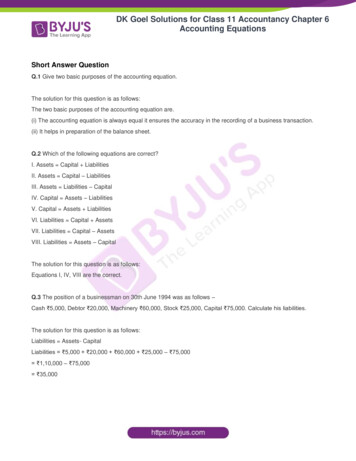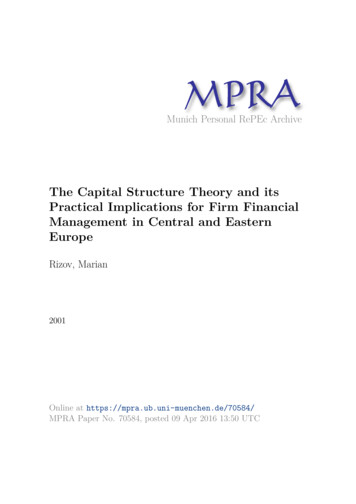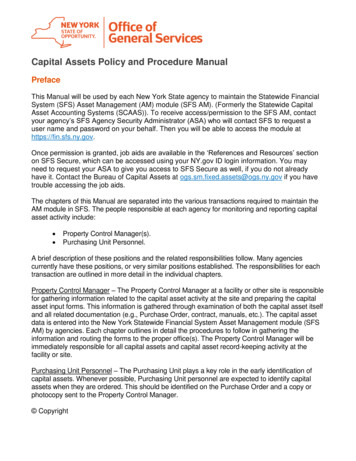
Transcription
Capital Assets Policy and Procedure ManualPrefaceThis Manual will be used by each New York State agency to maintain the Statewide FinancialSystem (SFS) Asset Management (AM) module (SFS AM). (Formerly the Statewide CapitalAsset Accounting Systems (SCAAS)). To receive access/permission to the SFS AM, contactyour agency’s SFS Agency Security Administrator (ASA) who will contact SFS to request auser name and password on your behalf. Then you will be able to access the module athttps://fin.sfs.ny.gov.Once permission is granted, job aids are available in the ‘References and Resources’ sectionon SFS Secure, which can be accessed using your NY.gov ID login information. You mayneed to request your ASA to give you access to SFS Secure as well, if you do not alreadyhave it. Contact the Bureau of Capital Assets at ogs.sm.fixed.assets@ogs.ny.gov if you havetrouble accessing the job aids.The chapters of this Manual are separated into the various transactions required to maintain theAM module in SFS. The people responsible at each agency for monitoring and reporting capitalasset activity include: Property Control Manager(s).Purchasing Unit Personnel.A brief description of these positions and the related responsibilities follow. Many agenciescurrently have these positions, or very similar positions established. The responsibilities for eachtransaction are outlined in more detail in the individual chapters.Property Control Manager – The Property Control Manager at a facility or other site is responsiblefor gathering information related to the capital asset activity at the site and preparing the capitalasset input forms. This information is gathered through examination of both the capital asset itselfand all related documentation (e.g., Purchase Order, contract, manuals, etc.). The capital assetdata is entered into the New York Statewide Financial System Asset Management module (SFSAM) by agencies. Each chapter outlines in detail the procedures to follow in gathering theinformation and routing the forms to the proper office(s). The Property Control Manager will beimmediately responsible for all capital assets and capital asset record-keeping activity at thefacility or site.Purchasing Unit Personnel – The Purchasing Unit plays a key role in the early identification ofcapital assets. Whenever possible, Purchasing Unit personnel are expected to identify capitalassets when they are ordered. This should be identified on the Purchase Order and a copy orphotocopy sent to the Property Control Manager. Copyright
Table of ContentsTable of ContentsI.IntroductionA. Overviewa. General Overview and Purposeb. General Terms and DefinitionsII.Capital Asset CriteriaA. OverviewB. Assets to be includeda. Land and Land Improvementsb. Building Componentsc. Equipmentd. Renovations and Improvements to Buildings and Equipmente. Leased Assetsf. Leasehold Improvementsg. Construction in Progressh. Infrastructurei. Library Booksj. Works of Art and Historical Treasuresk. Intangible AssetsC. Capital Asset Accounting System ProcessingD. Reports Produced by the SystemE. Periodic AccountabilityIII.Acquiring a Capital AssetA. OverviewB. Methods of Acquisitiona. Purchaseb. Leasec. Constructiond. Donatione. ExchangesC. Procedures to Enter a Capital Asset into SCAASD. Document RetentionIV.Declaring a Capital Asset SurplusA. OverviewB. Types of SurplusesC. Preparation of Declaration of Surplus Form (If Necessary)V.Transferring a Capital AssetA. OverviewB. Responsibility and Procedure for TransfersC. Verifying Transfer of an Asseta. Receiving Agency2 Page
Table of Contentsb. Releasing AgencyD. Document RetentionVI.Retirement of a Capital AssetA. OverviewB. Types of Retirementa. Abandonedb. Casualty Lossd. Solde. Trade-Inf. ScrappedC. Completing the Proper FormsD. Verifying Asset RetirementE. Document RetentionVII.Modification of Capital Asset InformationA. OverviewB. Types of Modificationsa. Updating/Correcting a Capital Asset Recordb. Adding Additional Information to a Capital Asset Recordc. Deleting Information from a Capital Asset RecordC. Completing the Proper FormD. Verifying Asset ModificationE. Document RetentionVIII.Impairment of Capital AssetsA. OverviewB. Potential Causes of ImpairmentC. Impairment TestD. How to Measure ImpairmentE. Example of Impaired Capital AssetsIX.Physical InventoryA. OverviewB. ProceduresAppendix AAppendix BAppendix CAppendix DAppendix EAppendix FAppendix GSFS AM Screen Shots and FormsField DefinitionsAgency BU, Level Codes, Transaction Level Department ValuesAgency Location Codes (Building and Facility)Capital Asset Profile IDsAgency Fund Source CodesPublic Lands Law Citations3 Page
Chapter I. IntroductionChapter I. IntroductionA. OVERVIEWa. General Overview and PurposeThe State has a significant investment in capital assets such as land, land improvements,buildings, building improvements, infrastructure, library books, works of art, historical treasures,intangible assets, machinery and equipment. In a major effort to improve financial reporting,accountability and operational efficiencies in managing these assets, the State has establishedthe Statewide Financial System (SFS) Asset Management (AM) module (SFS AM).The SFS AM houses capital asset information for financial reporting and inventory purposes. Thecapital assets are reported in the Statement of Net Assets included in the State’s Basic FinancialStatements. Assets of Public Benefit Corporations (PBCs), which are properly included in thePBC’s financial statements, prepared in accordance with Generally Accepted AccountingPrinciples (GAAP), are not recorded in the Statement of Net Assets. For years ending after April1, 1987, the State is required by law (Chapter 405, Laws of 1981) to report on this account group.The primary purpose of the system is to maintain auditable information on the State's capitalassets in accordance with GAAP. It is the desire of the State to receive and retain an unqualifiedaudit opinion for capital assets, as well as the Government Finance Officers Association (GFOA)Certificate of Achievement. This type of recognition would assist the State in obtaining the bestpossible bond ratings and enhance the accountability for capital assets.In addition, the SFS AM is manually linked to the State’s Real Estate Management (REM)coordinated by the Bureau of Land Management (BLM). Asset data entered using SFS AM ismanually linked to BLM, and BLM maintains the State Land Inventory, dispositions of State Land,the transfers of jurisdiction of State lands from one agency to another and the declarations ofsurplus buildings and improvements. To facilitate this management, BLM has and maintains,Grantee/Grantor indices for colonial patents and post-revolutionary sales and mapping of Stateowned land.Legal authority and responsibility to maintain the State Land Inventory is provided to the NewYork State Office of General Services (OGS) under § 2 (2) of the Public Lands Law. SeeAppendix G for a citation.The historical and replacement cost of an asset, as well as the asset's location, physical conditionand utilization rate, are examples of the information collected, stored and made available in avariety of reports produced by the SFS AM.It is the agency's responsibility to maintain accurate capital asset information on thesystem. The OGS, Bureau of Capital Assets (BCA) and BLM act as service bureaus to theagencies, monitoring and coordinating inputs to the system, maintaining the capital assetsdatabase and distributing reports. Centralizing this information in a single master file enablesthe State and agency managers to effectively budget, account for, and control the acquisitionand disposition of capital assets.Chapter I. Introduction4 Page
The purpose of this Manual is to provide agencies with an understanding of the SFS AM inrelation to their roles and responsibilities for maintaining it.Chapter II outlines which assets are to be included and capital asset criteria. Chapters III throughVI outline the steps an agency must follow when acquiring, declaring surplus, and transferring orretiring (i.e., disposing of) a capital asset.Chapter VII outlines the steps required to update or modify information already on the master file,and Chapter VIII outlines the issues of impairment. Chapter IX describes the procedures forperforming a physical inventory of the capital assets.The appendices contain: Screen Shots and Forms (Appendix A); Field Definitions (Appendix B);Agency Business Units, Level Codes, Transaction Level Department Values (Appendix C);Agency Location Codes (Building and Facility) (Appendix D); Capital Asset Profile IDs (AppendixE); Agency Fund Source Codes (Appendix F); and Public Lands Law Citations (Appendix G).b. General Terms and DefinitionsAbandonment – The disposal or retirement of an asset due to the complete deterioration or lackof usefulness. This occurs when an asset ages and the wear and tear either renders it useless orcosts too much to maintain the asset. An example of this would be a large dump truck that, after20 years, must be repaired every 10 days and eventually becomes non-operating. Refer toChapter VI, Section B, Part a.Abandonment of State Real Property – Public Lands Law § 30-a. The head of any stateagency having custody or jurisdiction over state-owned lands may determine that such lands areno longer necessary or useful to the purposes of such agency. Upon the filing of a declaration ofabandonment of such lands with an approval thereof by the Commissioner of the New York StateOffice of General Services such lands shall become unappropriated state lands.Activity Report – A report received by a Property Control Manager that summarizes capitalasset transactions for a given period. Examples of activity reports include capital asset additions,transfers, disposals and adjustments.Addition – The acquisition of a capital asset through purchase, construction, donation or capitallease. The asset is acquired to be used in the ordinary course of an agency's normal operations.The acquisition is not made with the intent to resell or consume the asset (i.e., supplies). Refer toChapter III, Section B.Ad-hoc Reports – Reports requested by an agency that are not produced on a periodic basis.Agencies are permitted to request "Tailor Made" reports for their specific needs. The BCA willconsider each of these reports and respond to the agency request.Chapter I. Introduction5 Page
Chapter I. IntroductionAdjustments – Any change to the cost of a capital asset. All changes in prices must go throughthe BCA. This can result from additional costs incurred after the initial purchase of the asset toplace it in working order (e.g., constructing a slab to put a large machine on).Agency Level Code – The two-digit agency prefix number to be entered into the SFS AM in frontof the Tag Number. This identifies the business unit that owns the asset. Refer to Appendix C.Amortization – When applied to a capital asset, amortization is the allocation of its cost over theperiod of its economic benefit. Amortization is calculated by expensing a prorated portion of thecapital asset’s cost each year of its estimated useful life. Amortization is computed with respect toan asset’s period of benefit and may be applied to both tangible and intangible assets. For mostpurposes, the term “depreciation,” is deemed to include “amortization”.Ancillary Costs – Costs required to bring a capital asset into use. Such costs include delivery,installation, sales taxes, legal fees, documentation charges, etc.Asset (Tag) Number – The number (alphanumeric code) assigned to a capital asset to uniquelyidentify the asset among all other assets. The number will consist of a series of letters and/ornumbers that vary slightly depending on the type of asset and the method used to identify it. Thisnumber will be used to access and report on information related to the asset. Refer to Chapter III,Section C, Step 1.Asset System – A group of interdependent parts or components acquired to be used in thenormal operations of the agency. Examples of asset systems would be telephone system,computer equipment and closed-circuit security monitoring equipment.Auditable – Records and documentation are maintained in an orderly, accessible manner. Thisenables auditors to examine the records in support of capital assets. All records are expected tobe maintained in this manner.Bargain Purchase Option – A provision of a lease agreement that allows the lessee to purchase(typically at the end of the initial lease term) the leased asset at a price that is so low (generallysubstantially lower than the estimated fair market value) as to make its exercise relatively certain.Betterment – See Improvement.BCA - Bureau of Capital Assets – A statewide centralized bureau, which gathers, inputs andreports on capital asset information from the agencies. The bureau maintains an account of allcapital assets and coordinates the distribution of activity and management reports. The BCA maybe reached at:New York State Office of General ServicesBureau of Capital Assets32nd Floor, Corning TowerEmpire State PlazaAlbany, NY 122426 Page
Chapter I. IntroductionPhone: (518) 474-1021Email: OGS.sm.Fixed.Assets@ogs.ny.govWebsite: http://www.sfs.ny.govBuilding – A structure built for permanent use with at least three walls and a roof that is recordedin the SFS AM, broken down into 10 components, each recorded as an individual asset. Allbuildings, regardless of cost, are included in the SFS AM. Refer to Chapter II, Section B, Part b.Building Improvements – Fixtures, machinery and other items attached to or installed in Stateowned buildings in such a way that they cannot be removed without causing damage tothemselves or the buildings to which they are affixed.Business Unit (BU) – The SFS-assigned NYS agency or Business Unit in the SFS AM.Example: OGS11 is the Business Unit to use in the SFS AM for OGS; DOC11 is the BusinessUnit to use in SFS AM for DOCCS.Capitalization – For purposes of the SFS AM, capitalization is the recording of assets that meetthe following capital asset criteria: Equipment – Cost over 40,000 and has a useful life of two years or more.Building Improvements and Land Improvements – cost over 100,000 and has a usefullife of two years or more.All buildings and land (in other words, effective threshold is “ 0 or more” for buildingsand land).Infrastructure that costs over 1,000,000.Intangible Assets that cost over 1,000,000.Capitalization Threshold – The cost at or above which a long-lived asset should be capitalized.Amounts spent to acquire long-lived assets with a cost falling below the capitalization thresholdshould be expensed.Capital Asset – Any land, building, equipment, improvement, infrastructure or intangible that areused for government operations and meet the capitalization definition.Capital Asset Representative – The person or persons responsible for coordinating theagency’s capital assets.Capital Lease – A capital lease is an agreement between an agency and lessor whereby theagency makes periodic payments for the use of an asset in its normal operations. The terms ofthe lease are such that the agency in effect "owns" the asset. To determine if a lease qualifies asa capital lease, it is examined to see if it meets any one of the following four criteria:1. There is a bargain purchase option in the lease enabling the State to purchase the leasedasset for less than its current market value at the end of the lease term.2. There is a transfer of ownership of the asset to the State at the end of the lease term.3. The net present value of future minimum lease payments is 90 percent or more of the fairmarket value at the beginning of the lease term.7 Page
Chapter I. Introduction4. The lease term is 75 percent or more the economic useful life of the asset.A capital lease amounts to an installment purchase of the capital asset.Collection – Works of art, historical treasures, and similar assets, whether donated orpurchased, that meet all the following conditions:a. Held for public exhibition, education, or research in furtherance of public service, ratherthan financial gainb. Protected, kept unencumbered, cared for, and preservedc. Subject to an organizational policy that requires the proceeds from sales of collectionitems to be used to acquire other items for collectionComponent – One part of a group of separate parts that make up a capital asset. A componentcan be a single piece of equipment that is part of an asset system, or one of the 10 major buildingcomponents as described in Chapter II.Computer Hardware – Computer hardware consists of all the equipment that can be considereda component of, is typically attached to, or communicates with an information system. The termencompasses processing units, memory apparatus, input and output devices, storage devicesand connectivity equipment.Computer Software – There are two major categories of software: system software that controlsthe hardware components and enables the basic functions of the system, and applicationsoftware that is used to accomplish specific tasks such as word processing. Software may bepurchased from a vendor or developed internally.Construction – Building a structure or infrastructure as opposed to buying or leasing one alreadycomplete. This can be done by contracting an outside builder or using one of the threeconstruction agencies in the State. When a building is constructed, the total cost must be brokendown into the 10 major building components. Cost of construction includes all incidentalexpenditures made to place the asset into working order (e.g., materials, labor, licenses, fees,legal costs, etc.).Construction in Progress (CIP) – Construction in progress includes the costs incurred foruncompleted capital projects involving the construction or installation of buildings, improvements,roadways, bridges, etc. The term also extends to other capital assets, such as large computer ortelecommunication systems, which have been undertaken but not brought into service by the endof a reporting period.Cost – The price paid, to be paid, or deemed to have been paid to acquire an asset.Depreciation – The method of allocating historical cost of a capital asset over its estimateduseful life in a systematic and rational manner. The estimated useful life is the estimation of timethat the asset will provide the benefit of use.8 Page
Chapter I. IntroductionDisposals – The abandonment or retirement of a capital asset. An agency that sells, donates, orthrows away a capital asset must report it to the Bureau of Capital Assets following theprocedures in Chapter VI.Donation – Acquisition of capital asset for nothing in return. This pertains to assets given to anagency at no cost. The assets are to be valued at the fair market value of similar assets at thetime of donation. A “donation” from another agency should be treated as a transfer.Easement – An interest in land owned by another person for a specific purpose.Equipment – Any piece of machinery, vehicle, or other device that is used in the normaloperations of a State agency. The asset must cost more than 40,000 and have a useful life oftwo years or more. Examples of equipment include printing presses, computers, trucks, cranes,winches, and tractors.Estimated Historical Cost – An estimate of the purchase price of a capital asset. An estimatemay be derived from vendor price lists or catalogs, similar assets, staff estimates, or appraisals.This should only be assigned as the cost of a capital asset when the actual historical cost is notavailable.Facility Record – A record in the SFS AM that reflects the land that currently makes up a facility.This record contains all pertinent data related to the land.Fair Market Value – Fair market value is the amount at which an asset could normally beexchanged between willing parties. Fair market value at the time of acquisition can be estimatedby reference to manufacturers’ catalogs or price quotes in advertisements; contemporaneoussales of comparable assets; or, publications that specialize in listing prices of particular kinds ofassets. Fair market value can also be established by using the services of an industry appraiseror expert.GASB – Governmental Accounting Standards Board. The GASB is the body authorized toestablish accounting standards for state and local governments.GASB 34 – Statement Number 34, issued by the GASB, entitled “Basic Financial Statements –and Management’s Discussion and Analysis – for State and Local Governments.” Issued in June1999, this pronouncement established new reporting requirements and accounting standardsrelating to state and local governments’ capital assets.Grantee – Buyer of real property.Grantor – Seller of real property.Historical Cost – The cost incurred to acquire a capital asset and place it into service in thenormal operations of the agency. Cost includes amounts paid or value assigned (in the case of adonated asset) and any incidental costs incurred to place the asset into service, such as freight,9 Page
Chapter I. Introductioninstallation charges, preparation of the area in which the asset will be operated, etc. NOTE: Thecost of removing an old asset being replaced is not includable.Historical Treasures/Works of Art – An asset (building, work of art, artifact, place) that hasbeen declared historical by either the federal government or the State. These items are notdepreciated if they are maintained and held for public exhibition. The historical cost of these itemsmay be depreciated at an appraised value if they are donated.Impaired Capital Assets – Governments generally hold capital assets because of the servicesthe capital assets provide. Capital asset impairment is a significant, unexpected decline thataffects the service utility of the capital asset. The events or changes in circumstances that leadto impairments are not considered normal and ordinary.Improvements – Any additions to or costs incurred that increase the useful life of the assetand/or that will result in an asset performing functions that it previously did not perform.Improvements can be separated into two categories: additions to a previously existing asset, orreplacement of a component of plant or equipment with new part that significantly improves theasset’s performance. In each case the result will tend to enhance the overall efficiency of theasset and increase the useful life. Improvements must be separately identified from normalmaintenance and upkeep. Any expenditure made to keep an asset operating at its normalcapacity or preventing it from prematurely deteriorating, is considered maintenance and shouldnot be added to the value of the asset. An example of an improvement would be taking an oldengine out of a truck and replacing it with a newer, bigger one. Maintenance would be replacingthe oil, spark plugs and antifreeze in either the old or the new engine.Infrastructure – General government capital assets that are immovable and have value only tothe governmental unit, unless sold. Examples are roads, bridges, tunnels, dams, beaches,pedestrian and bicycle paths, drainage systems, lighting systems, water and sewer systems,piers, boardwalks and other similar items.Initial Inventory – The beginning inventory taken to establish the initial database for theStatewide Financial System Asset Management module (SFS AM). The agency will conduct itsown inventory and be responsible for reporting to the BCA.Intangible Asset – A resource lacking a physical substance. Copyrights, patents, easements,software and intellectual property are all examples of intangible assets.Installment Purchase – Purchase method calling for payment to be made in periodicinstallments. Transfer of ownership occurs at the time of the purchase, although this methoddelays the recognition of expense until payments are made.Land – A capital asset recorded individually by "parcel" in the SFS AM. All land, regardless ofcost, should be included in the system. After the initial recording, land will be maintained andreported on a facility basis using a "facility record". The land is recorded as a capital assetseparate from any improvements made to it. Only those improvements costing more than10 P a g e
Chapter I. Introduction 100,000 and having a useful life of two years or more should be included in the system andreported as land improvements.Land Improvements – Improvements following the acquisition of land are in this category.Such assets have a limited economic life. Obviously, these assets are not "tagged" in thesame way as furniture or equipment. However, accountability for the assets is necessary.Examples of land improvements include walkways, parking lots, streetlights, landscaping andfencing.Lease – An agreement entered by an agency, whereby periodic payments are made to aseparate entity outside the State for the right to use an asset, such as computers, buildings,vehicles, etc. See capital leased assets and operating leases.Lease/Purchase – A lease agreement entered whereby the ownership of the asset being leasedtransfers to the agency at some time during or at the end of the lease.Liber – A book of deeds.Location Code –The SFS AM eight-digit code that is the combined “old legacy” facility andbuilding numbers. (Ex. 0003-022 OMH - Buffalo - Maintenance shop; P001-002 DOCCS –Albion CF – Chapel). Refer to Appendix D.Loss – The involuntary disposal of a capital asset due to fire, flood, theft, vandalism, etc.Standard retirement procedures should be followed to report the loss to the SFS AM.Maintenance – The normal repairs and upkeep performed on an asset to keep it operating in anappropriate condition. These repairs will not prolong the life of the asset, but merely keep itoperating properly.Management Report – Reports produced by the SFS AM, which are available on the web or atthe request of agency management to BCA. Reports include information relevant to the cost ofreplacing capital assets, condition, location and status of capital assets, etc. These reports shouldbe used by the agency in determining the need to repair or replace capital assets. The preferredmethod for receiving management reports is from the SFS AM on the website.Modification – Changes made to an existing capital asset record to maintain current andaccurate information, including: Correcting or updating data.Adding data.Deleting data.All modifications are processed electronically.11 P a g e
Chapter I. IntroductionModified Approach – As provided for in GASB 34, a comprehensive system of conditionassessment and maintenance that, when rigorously applied to infrastructure assets, may be usedas an alternative approach to depreciation.Modify/Update – The process of changing an agency's existing data relating to a capital assetdue to reasons such as changes in site, condition or use. Records are updated electronically by aProperty Control Manager. Property Control Managers may receive an updated report from SFSAM for their records of these modifications.Operating Lease – Any lease agreement entered by the State that gives the agency the right touse a specific asset or group of assets for a period of time. At the end of the term, the asset isreturned to the entity it was leased from. The lease does not meet any of the 4 criteria listed in thecapital lease definition. The ownership of the asset does not transfer to the State at any timeduring the term of the lease.Parcel of Land – A continuous tract or plot of land in one’s possession, no part of which isseparated from the rest by land in another’s possession.Present Value – An amount determined by discounting a stream of future payments at a statedor imputed rate of interest.Profile ID – The 10-digit code in the SFS AM that is used to identify the asset (refer to AppendixE): Buildings begin with “B”.Equipment begins with “E”.Infrastructure begins with “I”.Intangibles begin with “N”.Land begins with “L”.Land Improvement begin with “A”.In this 10-digit code is the combined old legacy code (major/minor category) and includes theuseful life of the asset.Property Control Manager – The person responsible for gathering and maintaining informationrelated to capital asset activity at that agency's site. This information is gathered through physicalexamination of the asset and its related documentation. All capital assets and their activities arethe immediate responsibility of the Property Control Manager. The Property Control Manager isfurther responsible for monitoring and reporting all capital asset information to the Bureau ofCapital Assets.Purchase – Acquiring an asset by paying for it, exchanging another asset for it, or a combinationof the two. Writing a check, paying cash, assuming a mortgage and trading in an old asset are allexamples of methods of purchasing an asset. Purchases are limited to acquisition of assetsdelivered and placed into service in the condition they were received in (e.g., already complete,12 P a g e
Chapter I. Introductionnot requiring construction). NOTE: Minor assembly in the case of equipment does not constituteconstruction.Real Property – land and anything growing on, attached to, or erected on it, excluding anythingthat can be severed without injury to the land.Reference to Source – A number or code denoting the type of document that generated theacquisition of a capital asset, such as a purchase order or contract number. This provides anaudit trail to support capital asset additions for a given period. An example would be the vouchernumber on a voucher used to pay for a computer, or the lease number on a capital lease.Renovation – Construction performed on an already existing building to enhance its usefulness.This also includes replacement of destroyed portions (e.g., fire damaged rooms). Costs must becarefully monitored, and an estimate of the percentage of the building component renovated mustbe made and reported for each
Capital Assets Policy and Procedure Manual Preface This Manual will be used by each New York State agency to maintain the Statewide Financial System (SFS) Asset Management (AM) module (SFS AM). (Formerly the Statewide Capital Asset Accounting Systems (SCAAS)). To receive access/permission to the SFS AM, contact


